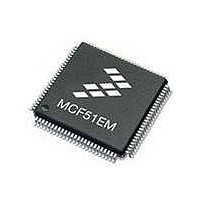MCF51EM256CLL Freescale Semiconductor, MCF51EM256CLL Datasheet - Page 252

MCF51EM256CLL
Manufacturer Part Number
MCF51EM256CLL
Description
IC MCU 32BIT 256KB FLASH 100LQFP
Manufacturer
Freescale Semiconductor
Series
MCF51EMr
Datasheets
1.MCF51EM128CLL.pdf
(2 pages)
2.MCF51EM128CLL.pdf
(54 pages)
3.MCF51EM128CLL.pdf
(636 pages)
Specifications of MCF51EM256CLL
Core Processor
Coldfire V1
Core Size
32-Bit
Speed
50MHz
Connectivity
I²C, SCI, SPI
Peripherals
LCD, LVD, PWM, WDT
Number Of I /o
63
Program Memory Size
256KB (256K x 8)
Program Memory Type
FLASH
Ram Size
16K x 8
Voltage - Supply (vcc/vdd)
1.8 V ~ 3.6 V
Data Converters
A/D 16x12b
Oscillator Type
External
Operating Temperature
-40°C ~ 85°C
Package / Case
100-LQFP
Processor Series
MCF51EM
Core
ColdFire V1
Data Bus Width
32 bit
Data Ram Size
16 KB
Interface Type
RS-232, LIN
Maximum Clock Frequency
50 MHz
Number Of Timers
3
Operating Supply Voltage
1.8 V to 3.6 V
Maximum Operating Temperature
+ 85 C
Mounting Style
SMD/SMT
3rd Party Development Tools
JLINK-CF-BDM26, EWCF
Development Tools By Supplier
DEMOEM
Minimum Operating Temperature
- 40 C
Lead Free Status / RoHS Status
Lead free / RoHS Compliant
Eeprom Size
-
Lead Free Status / Rohs Status
Lead free / RoHS Compliant
Available stocks
Company
Part Number
Manufacturer
Quantity
Price
Company:
Part Number:
MCF51EM256CLL
Manufacturer:
FREESCALE
Quantity:
110
Company:
Part Number:
MCF51EM256CLL
Manufacturer:
Freescale Semiconductor
Quantity:
10 000
- Current page: 252 of 636
- Download datasheet (11Mb)
Interrupt Controller (CF1_INTC)
10.6.1
As noted in
masking is controlled by CCR[I], the interrupt mask flag: clearing CCR[I] enables interrupts, while setting
CCR[I] disables interrupts. The ColdFire architecture defines seven interrupt levels, controlled by the 3-bit
interrupt priority mask field in the status register, SR[I], and the hardware automatically supports nesting
of interrupts.
To emulate the HCS08’s 1-level IRQ capabilities on V1 ColdFire, only two SR[I] settings are used:
The ColdFire core treats the level seven requests as non-maskable, edge-sensitive interrupts.
ColdFire processors inhibit interrupt sampling during the first instruction of all exception handlers. This
allows any handler to effectively disable interrupts, if necessary, by raising the interrupt mask level
contained in the status register as the first instruction in the ISR. In addition, the V1 instruction set
architecture (ISA_C) includes an instruction (STLDSR) that stores the current interrupt mask level and
loads a value into the SR. This instruction is specifically intended for use as the first instruction of an
interrupt service routine that services multiple interrupt requests with different interrupt levels. For more
details see the ColdFire Family Programmer’s Reference Manual. A MOVE-to-SR instruction also
performs a similar function.
To emulate the HCS08’s 1-level IRQ nesting mechanisms, the ColdFire implementation enables interrupts
by clearing SR[I] (typically when using RTE to return to a process) and disables interrupts upon entering
every interrupt service routine by one of three methods:
10.6.2
Section 10.3.2, “INTC Programmable Level 6, Priority {7,6} Registers (INTC_PL6P{7,6}),”
control registers that provide the ability to dynamically alter the request level and priority of two IRQs.
Specifically, these registers provide the ability to reassign two IRQs to be the highest level 6 (maskable)
requests. Consider the following example.
Suppose the system operation desires to remap the receive and transmit interrupt requests of a serial
communication device (SCI1) as the highest two maskable interrupts. The default assignments for the
SCI1 transmit and receive interrupts are:
To remap these two requests, the INTC_PL6P{7,6} registers are programmed with the desired interrupt
source number:
10-16
•
•
1. Execution of STLDSR #0x2700 as the first instruction of an ISR.
2. Execution of MOVE.w #0x2700,SR as the first instruction of an ISR.
3. Static assertion of CPUCR[IME] that forces the processor to load SR[I] with seven automatically
•
•
Writing 0 to SR[I] enables interrupts.
Writing 7 to SR[I] disables interrupts.
upon the occurrence of an interrupt exception. Because this method removes the need to execute
multi-cycle instructions of #1 or #2, this approach improves system performance.
sci1_rx = interrupt source 20 = vector 84 = level 4, priority 3
sci1_tx = interrupt source 21 = vector 85 = level 4, priority 2
Emulation of the HCS08’s 1-Level IRQ Handling
Using INTC_PL6P{7,6} Registers
Table
MCF51EM256 Series ColdFire Integrated Microcontroller Reference Manual, Rev. 8
10-1, the HCS08 architecture specifies a 1-level IRQ nesting capability. Interrupt
Freescale Semiconductor
describes
Related parts for MCF51EM256CLL
Image
Part Number
Description
Manufacturer
Datasheet
Request
R

Part Number:
Description:
BOARD DEMO HARDWARE ONLY
Manufacturer:
Freescale Semiconductor
Datasheet:

Part Number:
Description:
IC MCU 32BIT 128KB FLASH 100LQFP
Manufacturer:
Freescale Semiconductor
Datasheet:

Part Number:
Description:
IC MCU 32BIT 128KB FLASH 80LQFP
Manufacturer:
Freescale Semiconductor
Datasheet:

Part Number:
Description:
IC MCU 32BIT 256KB FLASH 80LQFP
Manufacturer:
Freescale Semiconductor
Datasheet:
Part Number:
Description:
Manufacturer:
Freescale Semiconductor, Inc
Datasheet:
Part Number:
Description:
Manufacturer:
Freescale Semiconductor, Inc
Datasheet:
Part Number:
Description:
Manufacturer:
Freescale Semiconductor, Inc
Datasheet:
Part Number:
Description:
Manufacturer:
Freescale Semiconductor, Inc
Datasheet:
Part Number:
Description:
Manufacturer:
Freescale Semiconductor, Inc
Datasheet:
Part Number:
Description:
Manufacturer:
Freescale Semiconductor, Inc
Datasheet:
Part Number:
Description:
Manufacturer:
Freescale Semiconductor, Inc
Datasheet:
Part Number:
Description:
Manufacturer:
Freescale Semiconductor, Inc
Datasheet:
Part Number:
Description:
Manufacturer:
Freescale Semiconductor, Inc
Datasheet:
Part Number:
Description:
Manufacturer:
Freescale Semiconductor, Inc
Datasheet:











